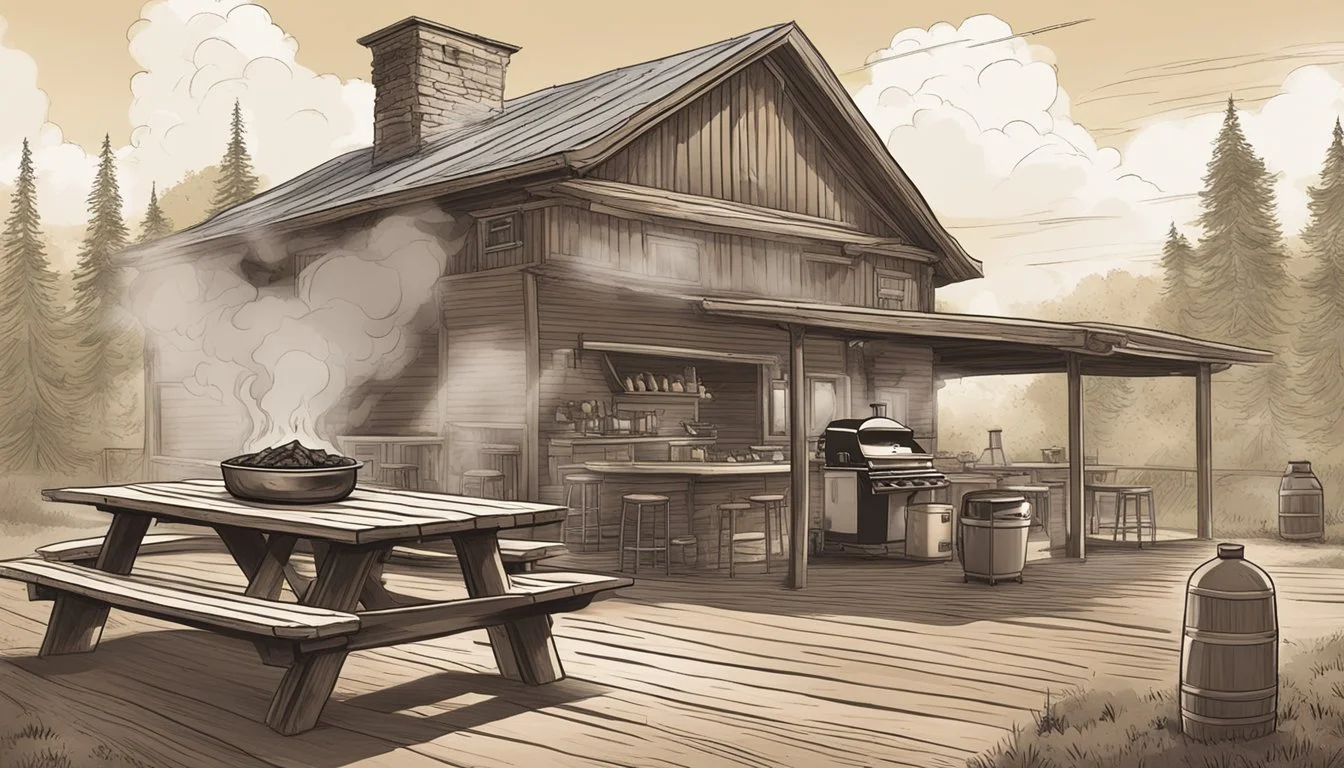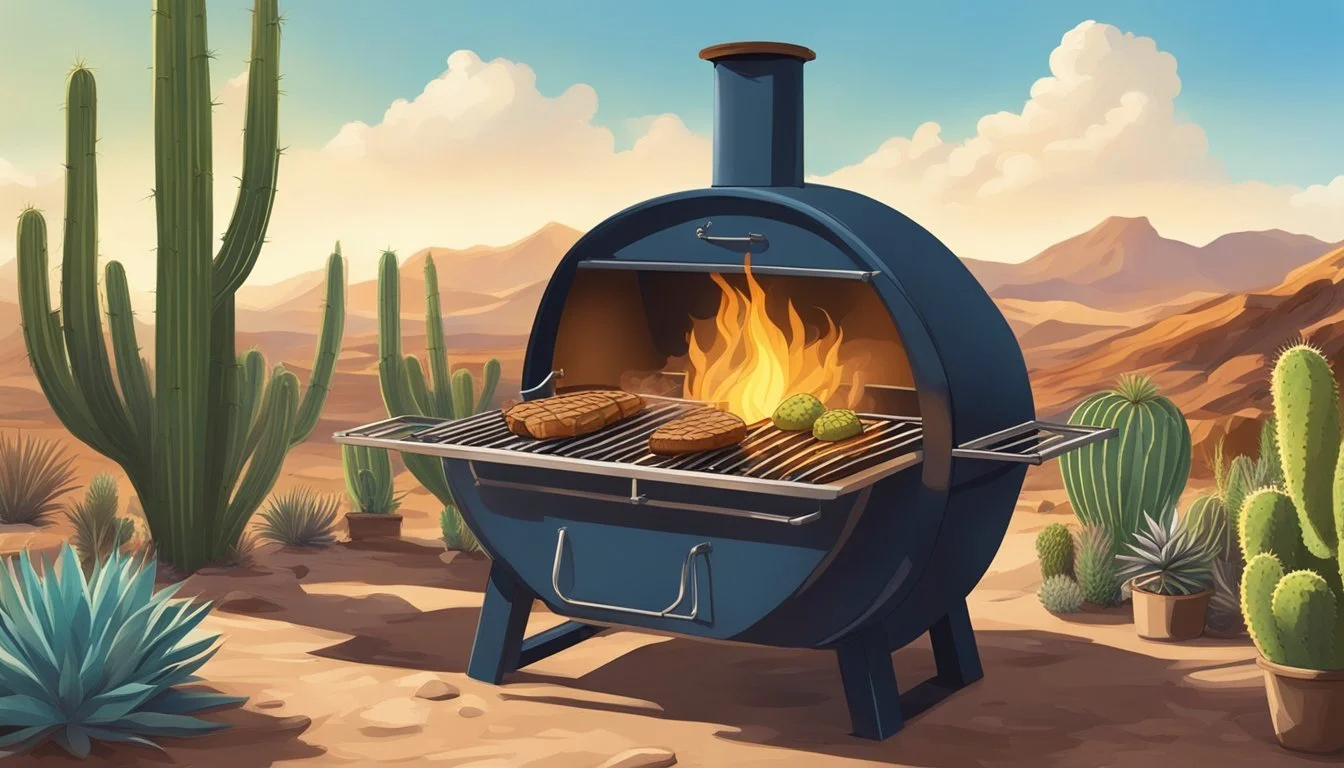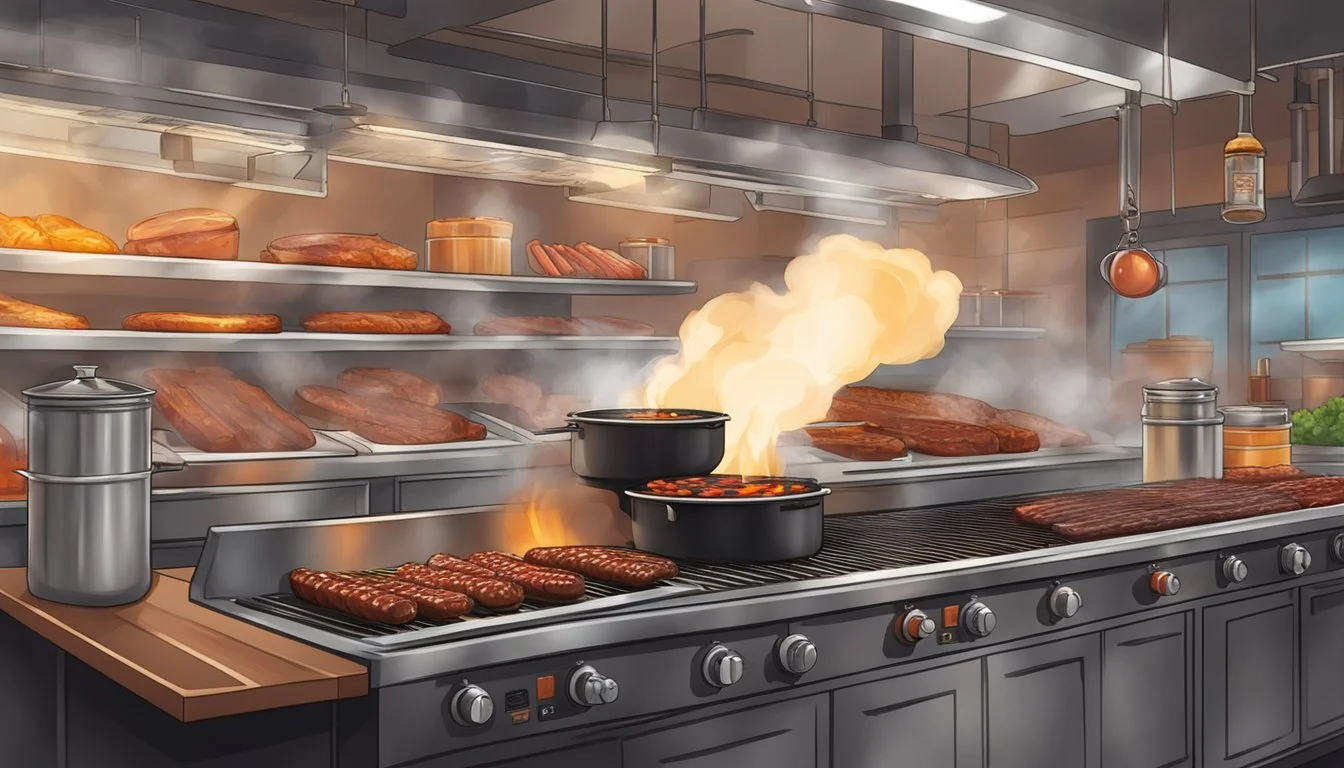South Texas BBQ
A Guide to the Region’s Best Smoked Meats
South Texas BBQ represents a tradition steeped in the rich culinary heritage of the Lone Star State. Distinct for its bold flavors and unique cooking methods, this BBQ style is characterized by its use of indirect heat from woodsmoke to cook and flavor the meat while imbuing it with the best flavors the region has to offer. It's not uncommon to find lean brisket, pork ribs, (What wine goes well with pork ribs?) and sausage dominating the menus at South Texas BBQ establishments, slow-cooked to perfection often over mesquite or oak wood which imparts a signature smokiness to the tender cuts.
In recent years, the appreciation for authentic Texas barbecue has grown, and venues like the barbecue (What wine goes well with barbecue?) joint Pinkerton's Barbecue in San Antonio, have found success by growing this cuisine to what we all know and love today. From house-made sausages, family barbecues, to food trucks, and established BBQ joints in South Texas, they have managed to establish a loyal following by offering a taste of Texas with a meticulous attention to the craft of barbecue, attracting both locals and visitors alike.
Barbecue enthusiasts can take pleasure in the variety offered at these joints, from the classic brisket full of beefy flavor to innovative takes on white bread sandwiches and tacos that feature barbecue. This culinary experience is not just about the food—it's also about the commitment to tradition and the celebration of community around shared tables and conversation, an ethos that South Texas BBQ joints cherish and uphold.
History of South Texas BBQ
South Texas BBQ interweaves traditional Mexican culinary methods with cowboy cooking practices. This barbecue tradition differentiates itself with a focus on moist, tender meats often accompanied by rich sauces.
Traditional Influences
South Texas barbecue, often known as "barbacoa," has a rich heritage that can be traced back to native Mexican cooking techniques. Compared to it East, Central, and West Texas counterparts, this traditional form of grilling meat typically involves slow-cooking cuts of meat, such as beef, lamb, or goat, in an underground pit that's lined with agave leaves. The meat is meticulously wrapped and left to cook overnight, yielding a dish that's tender and rich in flavor, making it a popular choice for weekend gatherings and celebrations. The use of local meats and cooking methods that predate modern ovens is a nod to the native ingredients, while the cultural integration of the cuisine brings together Spanish and Native American influences along with the cattle ranching culture.
Evolution of South Texas Barbecue
The evolution of South Texas barbecue is distinct from Central Texas barbecue, which is known for its emphasis on the smokiness of the meats. In contrast, South Texas style places a greater emphasis on the sauces, which often incorporate Mexican spices. This evolution can be credited to the Vaqueros, or Mexican cowboys, who brought about significant influence on the cowboy style of cooking, particularly in the development of techniques for preparing meats over an open fire. Over time, there has been a transition from pit-style barbacoa to above-ground smoking and grilling. Additionally, the adoption and adaptation of Mexican spices into mopping sauces have added layers of flavor and moisture to the barbecue.
This culinary evolution has helped maintain the distinct identity and traditional roots of South Texas BBQ, while also embracing new methods that have kept the cuisine both relevant and cherished by many.
Key Ingredients and Flavors
In South Texas BBQ, the selection of meats, the woods used for smoke, and distinctive rubs and sauces are fundamental to its unique taste profile.
Choice of Meats
South Texas BBQ traditionally focuses on beef cuts, with brisket and beef ribs being particularly popular choices due to their flavor and texture. These cuts, like beef brisket, are well-suited for the low and slow cooking process that is characteristic of barbecue, which helps in achieving the desired tenderness. Pork ribs are also commonly used, selected for their ability to sustain the slow cooking process and contribute to a diverse barbecue experience.
Woods and Smoke
In South Texas BBQ, mesquite wood plays a pivotal role, known for its assertive smoke flavor that imparts a strong, earthy taste to the meat. The smoke from mesquite is integral to the cooking process, enveloping the meat to infuse it with a distinctive, bold, and robust flavor. In contrast, hickory wood offers a sweet bacon-like flavor with a much more pungent smoke that can be used for a variety of meats.
Rubs and Sauces
In South Texas, the art of seasoning is essential to the barbecue experience, with rubs often featuring coarse black pepper, cumin, garlic powder, (how long does garlic powder last?) and chili powder. This ensures that these spices are carefully selected to create a robust outer crust that complements the natural flavors of the meat. When it comes to a focus on sauces for barbecue, there is a range of varieties that may include spicy, tangy, or sweet sauce flavors. The base of these sauces can vary, incorporating tomato, vinegar, or mustard (how long does mustard last?), but they are crafted to enhance rather than overpower the intrinsic smoky taste and the succulence of the meat.
Cooking Techniques
The signature cooking techniques in South Texas BBQ revolve around mastering heat control to produce perfectly smoked meats (What wine goes well with smoked meats?).
Low and Slow Philosophy
In the world of South Texas BBQ, the revered "low and slow" method is the cornerstone of cooking. This time-honored technique involves smoking meats such as brisket and beef ribs over a low indirect heat for an extended period. Pitmasters meticulously maintain the temperature within the sweet spot of 225°F to 275°F, which is crucial for achieving a tender and flavorful outcome.
A smoked brisket is typically in the smoker for 10-12 hours, while beef ribs often require 6-8 hours. This slow cooking process is essential as it allows the collagen in these tougher cuts to break down, ensuring that the meat becomes moist and tender, delivering the signature texture that South Texas BBQ is celebrated for.
Pitmasters' Secrets
Pitmasters employ indirect heat when smoking meats, a method that ensures a slow and gentle cook, suffusing the meat with a rich smoky flavor while preventing the outside from charring or becoming overcooked.
The placement of the meats inside the smoker is carefully considered to ensure they are exposed to the ideal balance of heat and smoke for even cooking. The expertise of pitmasters is evident in their comprehensive knowledge of the different types of meats, the nuanced behavior of the smoker, and the distinct properties of their chosen fuel, often mesquite wood.
They meticulously manage the smoker's vents and airflow to keep the temperature steady and the smoke at the desired intensity, guaranteeing the excellence of the finished dish.
Social and Culinary Impact
In the landscape of South Texas BBQ, restaurants serve as crucial social centers while the cuisine has left a sizable mark on culinary scenes both locally and internationally.
BBQ Joints as Community Hubs
In South Texas, BBQ joints are more than mere restaurants; they are vibrant community hubs where people gather. They offer a service that transcends the act of dining, fostering a sense of togetherness and local pride. The atmosphere is often casual and friendly, encouraging patrons to linger and socialize over plates of smoked meats and sides. The slow nature of BBQ cooking lends itself to this leisurely service style, allowing conversations to flourish. One standout element often found on the menus of these hubs is tacos, a staple that combines the region's love for barbecue with its Mexican culinary heritage.
Influence Beyond Texas Borders
The influence of South Texas BBQ has extended far beyond the state's borders by getting elements from Mexican cuisine and other regions, shaping the larger barbecue conversation. Eateries specializing in this style have popped up across the nation, introducing the flavors of South Texas - such as barbacoa, often cooked in underground coal pits - to new audiences. As a business, South Texas BBQ establishments have set benchmarks for quality and flavor, inspiring others to emulate their approach and creating a growing appreciation for barbacoa and other regional specialties. This regional fare has not only contributed to the global lexicon of barbecue but has also sparked a culinary dialogue that continues to evolve.
Modern Innovations and Trends
In recent years, South Texas BBQ joints have embraced new culinary techniques and flavors that goes beyond your average backyard barbecue cookbook, enhancing their traditional barbecue repertoire with modern, creative twists.
Fusion Dishes and Variations
South Texas has witnessed an emergence of fusion dishes that marry classic BBQ elements with international flavors. Unique sandwiches combining slow-smoked meats with diverse cuisines have become a staple, as they cater to an eclectic palate. These offerings reinvent the traditional by integrating authentic South Texas barbecue into inventive forms—tacos filled with brisket or banh mi sandwiches boasting smoked pork, for instance, demonstrate this delicious melding of cultures.
Gourmet and Artisanal Approaches
The region's BBQ joints have also started to adopt more gourmet and artisanal approaches to their craft. High-quality, locally-sourced ingredients are at the forefront of this trend, ensuring each dish's freshness and supporting the local economy. Modern barbecue enthusiasts can expect to find meticulous attention to detail in every aspect, from the choice of wood for smoking to the homemade sauces and sides that accompany the main course. This dedication to quality elevates the traditional BBQ experience to new heights of flavor and sophistication.
The BBQ Experience in South Texas
Before you go out and go on a barbecue road trip to check out that Amateur Barbecue Competition that you've been eyeing, it's important to know that South Texas offers a unique barbecue experience that is reflective of its regional tastes and the passion that comes from ambitious pitmasters of the region. It stands apart in flavor and tradition from its Central and East Texas counterparts.
Popular BBQ Joints and Pitmasters
Barbecue cuisine is a revered tradition in Texas, where the art of smoking and grilling meats is passed down through generations and celebrated as a cornerstone of local culture. Each city brings its own unique flair of craft barbecue to the table, with San Antonio and Brownsville being no exceptions. These cities boast a range of BBQ joints that are deeply rooted in Texan barbecue heritage while also embracing new culinary perspectives.
In San Antonio, the barbecue community is invigorated by establishments like Two Bros. BBQ Market, which is known for its inventive take on classic dishes and, of course, heaps of flavor with each tray of barbecue. Here, patrons can indulge in meat sandwiches or their cheesy chop, a delightful combination of brisket paired with a cheesy concoction that epitomizes comfort food. The influence of renowned chef Jason Dady is evident, as the pitmasters at Two Bros. BBQ Market have skillfully navigated the balance between innovation and tradition, elevating the local barbecue scene.
Meanwhile, in Brownsville, the barbecue culture may not be as prominent, but the flavors are just as compelling, with pitmasters incorporating the quintessential South Texas flair into their creations. While these local barbecue artisans may not share the same widespread acclaim as their San Antonio counterparts, their expertise in crafting authentic regional barbecue is undeniable, offering a taste that is sure to satisfy any barbecue enthusiast's palate.
What to Expect When You Visit
Visitors should prepare for more than just a meal; a visit to a South Texas barbecue joint is an immersive experience. Here's a glimpse of what to expect:
When it come to service style, many places in South Texas honor the traditional counter-service style where the customer can often see the pit and smell the smoke as they approach the counter to order their meat by the pound.
While beefy flavor and meats typically includes well-seasoned, slow-smoked meats like that favor local wood, such as mesquite, to infuse a distinct flavor. While the sacred trinity—brisket, pork spareribs, and sausage—is common across the state, each region adds its own local twist to these classics.
South Texas tends to deviate from the Central Texas ideology of minimalism in sauces. Expect a bit more variety and experimentation that goes beyond your typical tomato-based sauce, but always anticipate staples like potato salad, beans, and coleslaw to complement your main course.
When visiting a South Texas barbecue joint, one can expect authenticity and creativity intertwined in every aspect, from the pitmasters who craft the meal to the very last bite.
South Texas Flavors
South Texas BBQ tradition is a testament to the rich tapestry of cultures and flavors that define the Lone Star State. It is a cuisine that has evolved over time, yet remains true to its roots, offering a smoky and savory experience that is as much about community and heritage as it is about the food. As local decades-old establishments have shown, even the most innovative and forward-thinking BBQ joints are built on the foundation of traditional techniques and flavors that have been passed down through generations.
Whether you're a lifelong resident or a curious traveler, the journey through South Texas BBQ is one of discovery and delight. From the smoldering pits of family-run establishments to the bustling counters of urban smokehouses, each bite tells a story of history, passion, and the pursuit of the perfect plate of barbecue. As you explore this culinary landscape, you'll find that South Texas BBQ isn't just a style of cooking—it's a way of life that celebrates the simple pleasures of good food, good company, and the enduring spirit of Texas.





